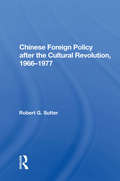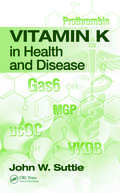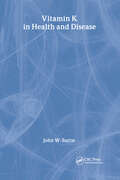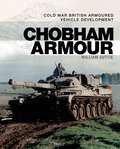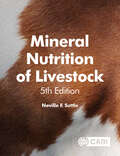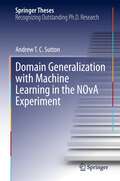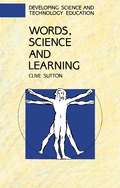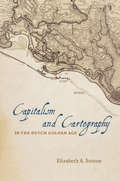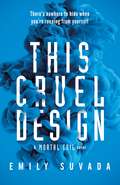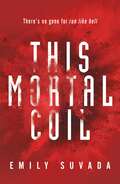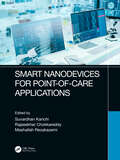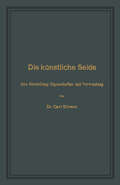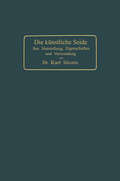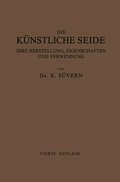- Table View
- List View
Chinese Foreign Policy/h
by Robert G. SutterChinese foreign policy has changed radically since the Cultural Revolution of 1966-1969. This book focuses on turning points in China's policy and looks at the influence of foreign pressures on China. It assesses the impact of internal political struggles on the conduct of Chinese foreign affairs.
Vitamin K in Health and Disease
by John W. SuttieVitamin K: Past, Present, Future Essential for normal blood coagulation, possible roles in bone, vascular, and tumor metabolism, and a nutrient critical to the health of the newborn infant -- these are just some of the many health-promoting aspects of Vitamin K. Vitamin K in Health and Disease navigates the exciting research venues that have opened
Vitamin K in Health and Disease
by John W. SuttieVitamin K: Past, Present, Future Essential for normal blood coagulation, possible roles in bone, vascular, and tumor metabolism, and a nutrient critical to the health of the newborn infant -- these are just some of the many health-promoting aspects of Vitamin K. Vitamin K in Health and Disease navigates the exciting research venues that have opened
Chobham Armour: Cold War British Armoured Vehicle Development
by William SuttieA comprehensive overview of the work of the Military Vehicles Research and Development Establishment on Chobham Common, which provided armoured vehicles for the British Army from 1945 to its close in 2004.Through much of World War II British tanks and armoured vehicles were outmatched by the German tanks they encountered and this led to the British Army placing much emphasis on ensuring that the same situation would not arise again if the Cold War turned hot. The task of developing the Main Battle Tanks and supporting armoured vehicles to out-range and quickly destroy the Soviet threat fell to the scientists and engineers at the Fighting Vehicle Research and Development Establishment on Chobham Common near to Chertsey. It was the design authority for all British Military vehicles for most of the period.Military vehicle and equipment expert William Suttie draws extensively on official MOD reports to tell the story of the development of the British Cold War armour, such as the Centurion, Chieftain, Challenger, and many other wheeled and tracked armour vehicles that served the British Army of The Rhine. The vehicles developed at the Chertsey site were never used for their intended purpose on the plains of North-west Germany, but have proved their worth in British operations in places like Korea, Bosnia, Kuwait, Iraq and Afghanistan, as well as in the hands of other users around the world.Fully illustrated with photographs, schemes and drawings, including some that have never been published before, this is a unique detailed overview of the development of all post-war British armoured vehicles.
Chobham Armour: Cold War British Armoured Vehicle Development
by William SuttieA comprehensive overview of the work of the Military Vehicles Research and Development Establishment on Chobham Common, which provided armoured vehicles for the British Army from 1945 to its close in 2004.Through much of World War II British tanks and armoured vehicles were outmatched by the German tanks they encountered and this led to the British Army placing much emphasis on ensuring that the same situation would not arise again if the Cold War turned hot. The task of developing the Main Battle Tanks and supporting armoured vehicles to out-range and quickly destroy the Soviet threat fell to the scientists and engineers at the Fighting Vehicle Research and Development Establishment on Chobham Common near to Chertsey. It was the design authority for all British Military vehicles for most of the period.Military vehicle and equipment expert William Suttie draws extensively on official MOD reports to tell the story of the development of the British Cold War armour, such as the Centurion, Chieftain, Challenger, and many other wheeled and tracked armour vehicles that served the British Army of The Rhine. The vehicles developed at the Chertsey site were never used for their intended purpose on the plains of North-west Germany, but have proved their worth in British operations in places like Korea, Bosnia, Kuwait, Iraq and Afghanistan, as well as in the hands of other users around the world.Fully illustrated with photographs, schemes and drawings, including some that have never been published before, this is a unique detailed overview of the development of all post-war British armoured vehicles.
Mineral Nutrition of Livestock
by Neville SuttleThe fifth edition of this important book reviews recent advances in livestock mineral nutrition, updated throughout with new references that reflect the growing complexity of mineral metabolism. Major related themes covered include the assessment of the 'mineral value' of feeds, the false hopes placed on organic mineral supplements and limiting the 'mineral footprint' of livestock production to lower environmental pollution. Also discussed are new developments and concepts including: Salt tolerance and optimizing production in salt-rich environments. Use of phytase rather than phosphate supplements in pig and poultry rations. Demineralization of the skeleton during confinement. Recognition of sub-acute, clinical hypocalcaemia as a disorder in dairy cows. The assay of 'free' plasma B12 to assess cobalt status of cattle. Limitations of cell culture and ligated loop techniques for assessing bioavailability. Following a clear and easy to reference structure, the book also considers potential pitfalls, such as misleading estimates of mineral requirements for growth, and misinterpretation of genomic markers for mineral requirements and bioavailability of supplements. An essential resource for researchers and students in animal nutrition, agriculture and veterinary medicine, this book also forms a useful reference for veterinary practitioners and those concerned with human nutrition and environmental protection.
Domain Generalization with Machine Learning in the NOvA Experiment (Springer Theses)
by Andrew T.C. SuttonThis thesis presents significant advances in the use of neural networks to study the properties of neutrinos. Machine learning tools like neural networks (NN) can be used to identify the particle types or determine their energies in detectors such as those used in the NOvA neutrino experiment, which studies changes in a beam of neutrinos as it propagates approximately 800 km through the earth. NOvA relies heavily on simulations of the physics processes and the detector response; these simulations work well, but do not match the real experiment perfectly. Thus, neural networks trained on simulated datasets must include systematic uncertainties that account for possible imperfections in the simulation. This thesis presents the first application in HEP of adversarial domain generalization to a regression neural network. Applying domain generalization to problems with large systematic variations will reduce the impact of uncertainties while avoiding the risk of falsely constraining the phase space. Reducing the impact of systematic uncertainties makes NOvA analysis more robust, and improves the significance of experimental results.
Words, Science and Learning (UK Higher Education OUP Humanities & Social Sciences Education OUP)
by Clive SuttonDespite the power of words to move minds, appreciating the written or spoken word is rarely thought to be the essence of teaching and learning science and much more effort goes into organizing practical work. There is an exaggerated confidence in the value of the direct experience of things as opposed to "mere words", and a corresponding neglect of how words are actually involved in developing anyone's scientific understanding. Clive Sutton does not wish to deny the value of first hand scientific understanding, and shows that they cannot just be taken for granted while we busy ourselves in the organization of practical work. He explores the role of language in the growth of science itself, in the growth of learners' ideas, and in classroom practice; and how these relate, for instance, to some pupils' alienation from science and the isolation of science in the curriculum.
Capitalism and Cartography in the Dutch Golden Age
by Elizabeth A. SuttonIn Capitalism and Cartography in the Dutch Golden Age, Elizabeth A. Sutton explores the fascinating but previously neglected history of corporate cartography during the Dutch Golden Age, from ca. 1600 to 1650. She examines how maps were used as propaganda tools for the Dutch West India Company in order to encourage the commodification of land and an overall capitalist agenda. Building her exploration around the central figure of Claes Jansz Vischer, an Amsterdam-based publisher closely tied to the Dutch West India Company, Sutton shows how printed maps of Dutch Atlantic territories helped rationalize the Dutch Republic’s global expansion. Maps of land reclamation projects in the Netherlands, as well as the Dutch territories of New Netherland (now New York) and New Holland (Dutch Brazil), reveal how print media were used both to increase investment and to project a common narrative of national unity. Maps of this era showed those boundaries, commodities, and topographical details that publishers and the Dutch West India Company merchants and governing Dutch elite deemed significant to their agenda. In the process, Sutton argues, they perpetuated and promoted modern state capitalism.
Capitalism and Cartography in the Dutch Golden Age
by Elizabeth A. SuttonIn Capitalism and Cartography in the Dutch Golden Age, Elizabeth A. Sutton explores the fascinating but previously neglected history of corporate cartography during the Dutch Golden Age, from ca. 1600 to 1650. She examines how maps were used as propaganda tools for the Dutch West India Company in order to encourage the commodification of land and an overall capitalist agenda. Building her exploration around the central figure of Claes Jansz Vischer, an Amsterdam-based publisher closely tied to the Dutch West India Company, Sutton shows how printed maps of Dutch Atlantic territories helped rationalize the Dutch Republic’s global expansion. Maps of land reclamation projects in the Netherlands, as well as the Dutch territories of New Netherland (now New York) and New Holland (Dutch Brazil), reveal how print media were used both to increase investment and to project a common narrative of national unity. Maps of this era showed those boundaries, commodities, and topographical details that publishers and the Dutch West India Company merchants and governing Dutch elite deemed significant to their agenda. In the process, Sutton argues, they perpetuated and promoted modern state capitalism.
Capitalism and Cartography in the Dutch Golden Age
by Elizabeth A. SuttonIn Capitalism and Cartography in the Dutch Golden Age, Elizabeth A. Sutton explores the fascinating but previously neglected history of corporate cartography during the Dutch Golden Age, from ca. 1600 to 1650. She examines how maps were used as propaganda tools for the Dutch West India Company in order to encourage the commodification of land and an overall capitalist agenda. Building her exploration around the central figure of Claes Jansz Vischer, an Amsterdam-based publisher closely tied to the Dutch West India Company, Sutton shows how printed maps of Dutch Atlantic territories helped rationalize the Dutch Republic’s global expansion. Maps of land reclamation projects in the Netherlands, as well as the Dutch territories of New Netherland (now New York) and New Holland (Dutch Brazil), reveal how print media were used both to increase investment and to project a common narrative of national unity. Maps of this era showed those boundaries, commodities, and topographical details that publishers and the Dutch West India Company merchants and governing Dutch elite deemed significant to their agenda. In the process, Sutton argues, they perpetuated and promoted modern state capitalism.
Capitalism and Cartography in the Dutch Golden Age
by Elizabeth A. SuttonIn Capitalism and Cartography in the Dutch Golden Age, Elizabeth A. Sutton explores the fascinating but previously neglected history of corporate cartography during the Dutch Golden Age, from ca. 1600 to 1650. She examines how maps were used as propaganda tools for the Dutch West India Company in order to encourage the commodification of land and an overall capitalist agenda. Building her exploration around the central figure of Claes Jansz Vischer, an Amsterdam-based publisher closely tied to the Dutch West India Company, Sutton shows how printed maps of Dutch Atlantic territories helped rationalize the Dutch Republic’s global expansion. Maps of land reclamation projects in the Netherlands, as well as the Dutch territories of New Netherland (now New York) and New Holland (Dutch Brazil), reveal how print media were used both to increase investment and to project a common narrative of national unity. Maps of this era showed those boundaries, commodities, and topographical details that publishers and the Dutch West India Company merchants and governing Dutch elite deemed significant to their agenda. In the process, Sutton argues, they perpetuated and promoted modern state capitalism.
Nitrogen Deposition, Critical Loads and Biodiversity
by Mark A. Sutton Kate E. Mason Lucy J. Sheppard Harald Sverdrup Richard Haeuber W. Kevin HicksThis volume brings together extended reviews and papers of new scientific research on atmospheric nitrogen deposition impacts globally. While there is a wealth of evidence on the magnitude, components and effects of nitrogen disposition on floral biodiversity in Europe and North America, there is an obvious lack of information on impacts on above- and below-ground fauna, and all impacts in other parts of the world, with no clear overview of how the different strands of evidence fit together. This overall synthesis is targeted at the international conventions, but is equally readable for scientists, environmental managers, conservation agencies and policy makers. 'This timely book highlights the global nitrogen deposition problem. Major regions of the world are exceeding sustainability thresholds for adverse effects on ecosystem function and biodiversity. This highlights the importance of ongoing work, including under the Convention on Biological Diversity, in developing indicators and monitoring nitrogen deposition effects to enable appropriate measures. This book presents a milestone towards this global goal as the international community works toward meeting the Aichi Biodiversity Targets, especially Target 8: "By 2020, pollution, including from excess nutrients, has been brought to levels that are not detrimental to ecosystem function and biodiversity". Braulio Ferreira de Souza Dias, Executive Secretary, Convention on Biological Diversity “This key volume highlights the global challenge to reduce atmospheric nitrogen pollution resulting from energy production, transport and agricultural activities. It takes forward the agenda recently launched in the UNEP commissioned report ‘Our Nutrient World”. Dr. Anjan Datta, UNEP.
Image Correlation for Shape, Motion and Deformation Measurements: Basic Concepts,Theory and Applications
by Michael A. Sutton Jean Jose Orteu Hubert SchreierImage Correlation for Shape, Motion and Deformation Measurements provides a comprehensive overview of data extraction through image analysis. Readers will find and in-depth look into various single- and multi-camera models (2D-DIC and 3D-DIC), two- and three-dimensional computer vision, and volumetric digital image correlation (VDIC). Fundamentals of accurate image matching are described, along with presentations of both new methods for quantitative error estimates in correlation-based motion measurements, and the effect of out-of-plane motion on 2D measurements. Thorough appendices offer descriptions of continuum mechanics formulations, methods for local surface strain estimation and non-linear optimization, as well as terminology in statistics and probability. With equal treatment of computer vision fundamentals and techniques for practical applications, this volume is both a reference for academic and industry-based researchers and engineers, as well as a valuable companion text for appropriate vision-based educational offerings.
International Digital Imaging Correlation Society: Proceedings of the First Annual Conference, 2016 (Conference Proceedings of the Society for Experimental Mechanics Series)
by Michael Sutton Phillip L. ReuThis collection represents a single volume of technical papers presented at the Annual International DIC Society Conference and SEM Fall Conference organized by the Society for Experimental Mechanics and Sandia National Laboratories and held in Philadelphia, PA, November 7-10, 2016. The volume presents early findings from experimental, standards development and various other investigations concerning digital image correlation - an important area within Experimental Mechanics. The area of Digital Image Correlation has been an integral track within the SEM Annual Conference spearheaded by Professor Michael Sutton from the University of South Carolina. In 2016, the SEM and Sandia joined their collaborative strengths to launch a standing fall meeting focusing specifically on developments in the area of Digital Image Correlation. The contributed papers within this volume span numerous technical aspects of DIC including standards development for the industry.
Biomaterials for Cardiac Regeneration
by Erik J. Suuronen Marc RuelThis book offers readers a comprehensive biomaterials-based approach to achieving clinically successful, functionally integrated vasculogenesis and myogenesis in the heart. Coverage is multidisciplinary, including the role of extracellular matrices in cardiac development, whole-heart tissue engineering, imaging the mechanisms and effects of biomaterial-based cardiac regeneration, and autologous bioengineered heart valves. Bringing current knowledge together into a single volume, this book provides a compendium to students and new researchers in the field and constitutes a platform to allow for future developments and collaborative approaches in biomaterials-based regenerative medicine, even beyond cardiac applications.
This Cruel Design (Mortal Coil Ser.)
by Emily SuvadaWhere can you hide when you're running from yourself?Catarina thought they'd stopped the Hydra virus. She was wrong.After laying everything on the line to decrypt the vaccine, Cat realises that Lachlan's daemon code is in the panel of every person on the planet's surface. With it, he can reprogram humanity.She, Cole and Leoben set out to stop him, but they're on a timer. Cartaxus - the shadowy corporation that's both helped and hindered them - has a deadly end game in play. The virus is evolving, the vaccine is dying, and if Cat can't find Lachlan in three days, they'll use lethal code to wipe out every person on the planet.Their path takes them to Entropia, an underground city deep in the desert and home to the most extreme gene hackers, run by the queen of coding, Regina.Struggling with the revelations about her past, and plagued by strange visions, what Cat finds in Entropia is more than just a trail to Lachlan. Because in the vaulted chambers of Regina's kingdom, Cat is forced to question everything she knows and everyone she trusts, and discovers that the biggest threat of all may be buried in her own mind.'With a backdrop of amazing science and technology, This Mortal Coil is a smart, page-turning thriller that gave me chills. I couldn't put this book down.' - Laini Taylor, bestselling author of Daughter of Smoke and Bone.'I can't remember the last time I was so hooked by a book. Relentlessly paced, expertly plotted, and with a romance as tense and as captivating as her wicked twists, Emily Suvada has crafted an unputdownable story. I loved every terrifying page.' - Stephanie Garber, bestselling author of Caraval.'This Mortal Coil redefines "unputdownable." A thrilling, exhilarating read that's crackling with intelligence. Compelling characters and and incredible twists come together perfectly - I loved this book.' - Amie Kaufman, bestselling author of Illuminae.
This Mortal Coil (Mortal Coil Ser. #1)
by Emily Suvada*Shortlisted for the Waterstones Children's Book Prize 2018*3 billion lives at stake. 2 people who can save them. 1 secret hidden in their DNA. A breathtaking debut series about one girl's quest for answers in a genetically and technologically advanced future. There's no gene for RUN LIKE HELL.When a lone soldier, Cole, arrives with news of Lachlan Agatta's death, all hope seems lost for Catarina. Her father was the world's leading geneticist, and humanity's best hope of beating a devastating virus. Then, hidden beneath Cole's genehacked enhancements she finds a message of hope: Lachlan created a vaccine.Only she can find and decrypt it, if she can unravel the clues he left for her. The closer she gets, the more she finds herself at risk from Cartaxus, a shadowy organization with a stranglehold on the world's genetic tech. But it's too late to turn back.As the pieces fit together it's clear there is one final secret that Cat must unlock. A secret that will change everything.With the pace and twists of a thriller, an emotional sucker-punch, the exquisite world-building of the best fantasy, and an imagined future that sci-fi fans will love, THIS MORTAL COIL has all the ingredients to become the next phenomenon in YA.'With a backdrop of amazing science and technology, This Mortal Coil is a smart, page-turning thriller that gave me chills. I couldn't put this book down.' - Laini Taylor, bestselling author of Daughter of Smoke and Bone.'I can't remember the last time I was so hooked by a book. Relentlessly paced, expertly plotted, and with a romance as tense and as captivating as her wicked twists, Emily Suvada has crafted an unputdownable story. I loved every terrifying page.' - Stephanie Garber, bestselling author of Caraval.'This Mortal Coil redefines "unputdownable." A thrilling, exhilarating read that's crackling with intelligence. Compelling characters and and incredible twists come together perfectly - I loved this book.' - Amie Kaufman, bestselling author of Illuminae.
This Vicious Cure (This Mortal Coil #3)
by Emily Suvada*The extraordinary conclusion to the This Mortal Coil trilogy - who will survive the oncoming storm?*Two factions at warA plague that can't be stoppedA cure that could destroy them all . . .Cat's hacking skills weren't enough to keep her from losing everything - her identity, her past, and now her freedom. Meanwhile, the person who's stolen everything from her is close to realizing a hacker's dream: the solution to humanity's problems in gene form. Or so she thinks . . .But now a new threat has emerged - a threat that could bring the world to the brink of a devastating war.Both sides will stop at nothing to seize control of humanity's future, and that the centre of this war is Cat, and a race against the clock save millions of lives . . .The gripping finale to a series The Verge has called 'perfect YA sci-fi'
Smart Nanodevices for Point-of-Care Applications
by Suvardhan Kanchi, Rajasekhar Chokkareddy and Mashallah RezakazemiSmart Nanodevices for Point-of-Care Applications examines the latest trends on the capabilities of nanomaterials for point-of-care (PoC) diagnostics and explains how these materials can help to strengthen, miniaturize, and improve the quality of diagnostic devices. A thorough explanation of all-in-one nanosmart devices is included, incorporating all of the applications and fundamentals of these smart devices. This book provides practical information on the following: novel and effective smart materials, better-quality health management, effective management of a disease, potential point-of-care devices, and mobile nanosensors. Additional Features Includes in-depth research based collation of the latest trends of smart devices Provides practical information on all-in-one nanosmart devices Explains how nanomaterials can help to strengthen and improve the quality of diagnostic devices Emphasizes the development of smart nanodevices, especially the miniaturization aspect
Die künstliche Seide: Ihre Herstellung, Eigenschaften und Verwendung
by Karl SüvernDieser Buchtitel ist Teil des Digitalisierungsprojekts Springer Book Archives mit Publikationen, die seit den Anfängen des Verlags von 1842 erschienen sind. Der Verlag stellt mit diesem Archiv Quellen für die historische wie auch die disziplingeschichtliche Forschung zur Verfügung, die jeweils im historischen Kontext betrachtet werden müssen. Dieser Titel erschien in der Zeit vor 1945 und wird daher in seiner zeittypischen politisch-ideologischen Ausrichtung vom Verlag nicht beworben.
Die Künstliche Seide ihre Herstellung, Eigenschaften und Verwendung: Mit Besonderer Berücksichtigung der Patent-Litertur
by Karl SüvernDieser Buchtitel ist Teil des Digitalisierungsprojekts Springer Book Archives mit Publikationen, die seit den Anfängen des Verlags von 1842 erschienen sind. Der Verlag stellt mit diesem Archiv Quellen für die historische wie auch die disziplingeschichtliche Forschung zur Verfügung, die jeweils im historischen Kontext betrachtet werden müssen. Dieser Titel erschien in der Zeit vor 1945 und wird daher in seiner zeittypischen politisch-ideologischen Ausrichtung vom Verlag nicht beworben.
Die Künstliche Seide: Ihre Herstellung und Verwendung
by Karl Süvern H. FrederkingDieser Buchtitel ist Teil des Digitalisierungsprojekts Springer Book Archives mit Publikationen, die seit den Anfängen des Verlags von 1842 erschienen sind. Der Verlag stellt mit diesem Archiv Quellen für die historische wie auch die disziplingeschichtliche Forschung zur Verfügung, die jeweils im historischen Kontext betrachtet werden müssen. Dieser Titel erschien in der Zeit vor 1945 und wird daher in seiner zeittypischen politisch-ideologischen Ausrichtung vom Verlag nicht beworben.
